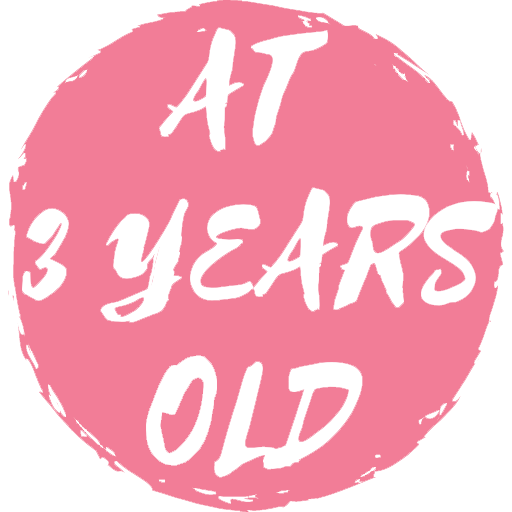What’s the Average Height of a 3-Year-Old?

And how you might be able to estimate how tall they will be as an adult.
I swear I can see my kids getting bigger by the day. I have such fond memories as a child, with my back against the door frame, dad marking my height. Then stepping back to see that I had grown another inch! Now I understand the pride my dad must have felt watching me grow.
So what is the average height for a 3-year-old? The average height for a 3-year-old girl is 34.5 – 40 inches (2.8 – 3.3 feet) tall1. The average height for a 3-year-old boy is 35.5 – 40.5 inches (2.9 – 3.4 feet) tall1. Although children might come in all shapes and sizes, let’s look at why their height might be important to track their growth. A growth chart is the most accurate way to see the average height of a 3-year-old.
Growth charts are vital to check if your 3-year-old’s height is on track. Also, excitingly, you can use them to estimate their adult height from their current height! I’ll show you how.
Remember, height can differ greatly between children. If your child is short or tall, it doesn’t mean they will necessarily stay that way when they grow up. Growth spurts will happen randomly throughout your child’s life.
Growth charts for your 3-year-old
You might have filled in weight charts to track your 3-year-olds development when they were a baby. Surprisingly, there are also growth charts which track their height, although less common these height charts are immensely useful. Especially if you want to check if your child is growing up healthy and strong.
Here are those growth charts for your child:
I find these growth charts extremely useful as it gives me peace of mind to know that my 3-year-old is developing normally. I have printed the chart and I mark my child’s height measurement every few weeks. It makes me so happy to see them healthy and growing, and I was so interested to see just how tall they might be when they were older.
What’s the best way to measure my 3-year-olds height?
If you want to use the growth charts or know accurately how tall your 3-year-old is. Then you need to learn how to measure your 3-year-olds height.
To measure their height the correct way with accuracy there are a few rules to follow to get it right. Accuracy is especially important if you are using their height to calculate their BMI (Body Mass Index).
The CDC recommends the following method to measure the height of your 3-year-old accurately:
- First, remove your 3-year-olds shoes, and bulky clothing (like coats or jumpers), hair ornaments. You may also want to unbraid hair if you feel it might interfere with the measurement.
- Take their height measurement on non-carpeted floor and against a flat surface with no molding on the wall.
- Have your 3-year-old stand with their feet flat on the floor, together, with their heels against the wall. Make sure their legs and arms are straight (by their sides) and their shoulders are level.
- Encourage your 3-year-old to look straight ahead and level. Not up or down.
- Try and get your 3-year-old to touch the wall with their head, shoulders, buttocks, and heels touching the flat wall behind them.
- Use something flat (like a book) and gently place it on top of their head touching the wall at a right angle.
- Mark where the bottom of the book (or another flat item) sits on the wall.
- Then your 3-year-old can step away from the wall and you can measure the height from the floor to the mark.
- This measurement is their height.
If you want to accurately measure how healthy your child’s growth is, then you can use this height measurement along with their weight and calculate their BMI (Body Mass Index). I wrote an article on how to calculate BMI easily.
My 3-year-old is short, should I worry?
If your 3-year-old is a little shorter than average height, then I wouldn’t be worried. At 3-years-old they have plenty of growth spurts to come. They might end even up becoming taller than their friends in the future.
Look at yourself and your family. Are you taller / shorter than average? As parents, your genes will have an effect on your child’s adult height.
If you have noticed that your child is in a much lower percentile in the growth charts (I provided a link for you at the start of the article). Then I would probably take a trip to talk with your doctor. Just to check that there aren’t any other reasons why your child is much shorter than average.
Diseases and development problems are rare but can be the cause of poor growth in your child. I’m not telling you this to worry you, but to remind you that sometimes it’s sensible to see a doctor and just check things out.
Examples of diseases and problems that could affect your child’s height
I have included this list of problems and diseases that can be linked to your child’s height2. I don’t want to scare you, but to raise awareness of these conditions. Although most of them are thankfully rare, they do affect children across the country.
Delay of growth
This condition may be inherited and symptoms are your child tends to be shorter than average and enters puberty later than average. Children with this issue do tend to catch up to their friends eventually and reach a normal adult height
Illnesses that affect their whole body
Examples are malnutrition over long periods of time, digestive tract diseases, kidney diseases, heart disease, lung disease, diabetes or chronic severe stress. Any of these conditions can cause growth issues.
Hormone Diseases
Your child’s growth can be affected by conditions that interfere with the bodies hormones. Examples of these conditions are:
- Thyroid problems
- Pituitary gland problems
- Growth hormone deficiency
- Cushing syndrome
- Precocious puberty
Intrauterine growth restriction (IUGR)
This is when the growth of a baby in the uterus is slowed. Causes of IUGR can be smoking during pregnancy or not enough prenatal care. Normally this means that the baby is born smaller in weight and length than normal.
Genetic disorders
These are disorders that are passed down to children through their parent’s genes. Examples of common genetic disorders are:
- Turner syndrome
- Down syndrome
- Achondroplasia
How are growth problems diagnosed in a 3-year-old?
Sometimes, growth problems can be diagnosed at birth. Your baby might be abnormally small for their gestational age. Otherwise, a growth problem can be noticed when your child’s growth is checked during regular exams by health professionals.
Diagnosis of any growth problems should be made by a healthcare professional. Normally they will consult a pediatric specialist. Your healthcare professional will ask about your 3-year-old’s symptoms and health history. They will probably also ask about your family’s health history.
The healthcare professional will give your 3-year-old a physical exam and they may check your 3-year-old’s health and growth over a number of months.
They might also request tests, such as:
- Blood tests: These can check for hormone, chromosomal, or other disorders that can cause growth problems.
- X-ray: This test uses a small and safe amount of radiation to make images of tissues inside the body. An x-ray may be taken of their hand and wrist. This can be used to estimate bone age. If your child has hormone problems bone age is often less than calendar age.
How would a growth problem be treated in my 3-year-old?
Fortunately, many conditions that cause growth problems in our children can be managed or corrected with medical treatment.
Your healthcare professional will base the treatment for any condition on:
- Your wishes about treatment
- Your child’s current health and health history
- How bad the problem is
- What is causing the growth problem
- How able your child is to deal with taking medicines and deal with procedures.
Some children may also develop poor self-esteem or even depression because of their height. You can talk to your child about their feelings and give them support about their height. Self-esteem and depression issues can also be addressed using psychological counseling.
Key Points to remember about growth problems in your 3-year-old
If you feel like your 3-year-old’s growth is a problem and you want to visit a healthcare professional like a doctor to discuss your child’s health. Then here is a useful list of tips to help you get the most from your visit:
- Write down the exact reason for your visit. It’s easy to forget the details when you only have a short time with your doctor.
- Write down any questions you want answering. It’s easy to forget important questions and regret it afterward.
- If your doctor gives your child a new diagnosis (the name for a condition) or prescribes them any medication. Then take a moment and write these down so you can research them later.
- Ask the doctor why a medicine or treatment has been prescribed and how it will help your child. Also, ask about side-effects.
- Ask about alternative treatments to their condition.
- Ask what tests might be done to confirm the diagnosis.
- Ask about what to expect if your child didn’t get treatment or misses a treatment.
- Ask for an out of hours contact number in case of any emergency.

Leave a Reply